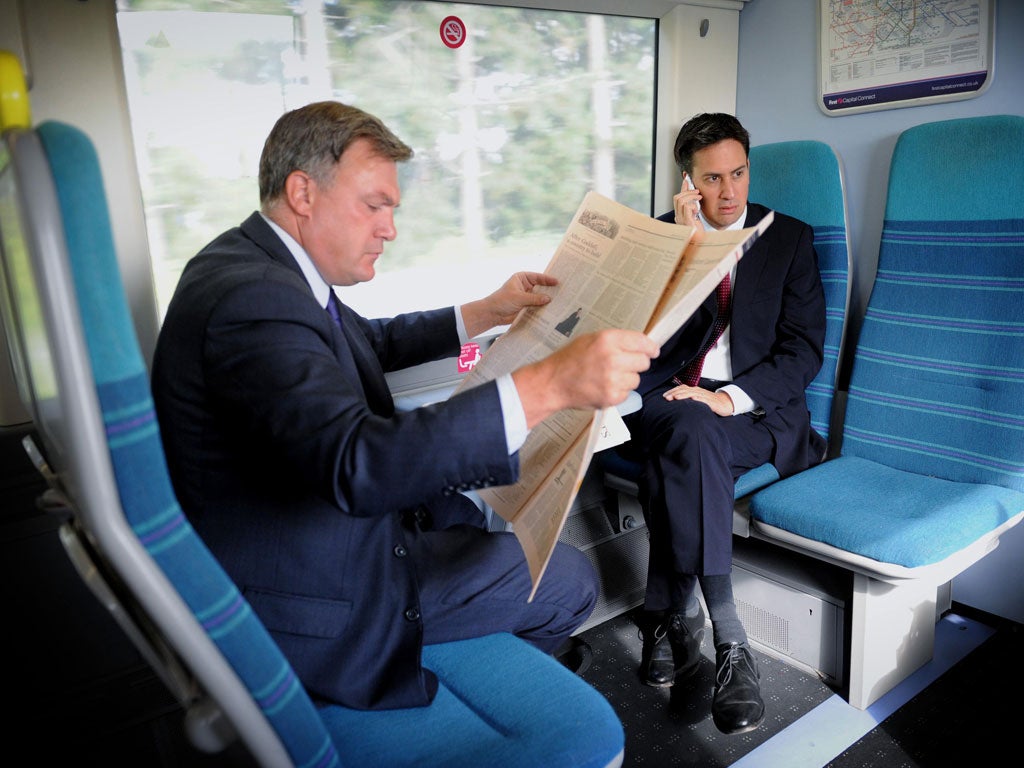John Rentoul: Forget Dave and George. The real story is the two Eds
Speculation about the Chancellor's future is wide of the mark and ignores deeper cracks at the top of the Opposition


My good colleague Hamish McRae turned out to be right about last month's figures for the economy. He said that they would be revised upwards. On Friday, the Office for National Statistics adjusted the figure for the second quarter of this year, and said that the economy shrank by only 0.5 per cent, rather than 0.7 per cent. Unfortunately for George Osborne, that revision is not nearly enough to wipe out the humiliation of a double-dip recession.
Something curious is going on with the economy, as McRae points out, because unemployment is falling, but, if the picture is rosier than the GDP figures suggest, we will not find out in time to save the Chancellor's reputation this month. Plan A is now so seriously adrift that one of Michael Gove's exam boards has marked it down to Plan B, as the comedian David Schneider said.
A ComRes poll last week found that only 16 per cent of voters "trust" Osborne to "see the country through the current economic situation". Yet the Chancellor is completely secure.
Unlike any relationship between Prime Minister and Chancellor since Margaret Thatcher started to suspect that Nigel Lawson was trying to "buck the market" in the mid-1980s, that between Cameron and Osborne is solid. Considering the scale of the economic crisis, the degree to which they are united on the policy of cutting the deficit is even more remarkable. With the single important exception of the decision to cut the top rate of income tax from 50p in the pound (Cameron and Nick Clegg united against Osborne to cut it to 45p rather than 40p at the last moment), they have been as one.
Partly, this is because Osborne accepts the Prime Minister's authority more readily than did most of his recent predecessors. For civil servants whose formative experiences were those of the Blair-Brown years, that was one of the most notable changes of the coalition. This is, in turn, partly the product of two parties working together in government – the division that matters is that between Cameron and his Liberal Democrat deputy. That tends to push Cameron and Osborne together.
The main reason for Cameron and Osborne's closeness, however, is their determination to learn from recent history, and the threat posed to governments by dissension between Nos 10 and 11 Downing Street. Cameron saw it from the inside as special adviser to Norman Lamont when the latter fell out with John Major. Osborne saw it in opposition as an adviser to William Hague when he fell out with his shadow chancellor, Michael Portillo. But mostly they saw it from the other side in the central enmity of the New Labour years between Tony Blair and Gordon Brown.
We would know if there were ideological differences between Prime Minister and Chancellor, or if Osborne were manoeuvring for the top job. No doubt Osborne is irritated by media speculation about Boris Johnson's ambitions, but he has more pressing things to worry about. Nor does he need to come out with such colourful denials of leadership ambitions as Michael Gove did last week, offering on live television to "sign a piece of parchment in my blood saying I don't want to be prime minister". Cameron and Osborne have seen what the Blair-Brown rivalry did to government, and vowed never to repeat it.
What a contrast with Labour, which seems to have replicated the dysfunctional relationship in new, convoluted ways. Ed Miliband and Ed Balls have been getting on particularly badly recently, although each has long found the other trying. Miliband was desperate not to have his intellectually confident former colleague as his shadow chancellor, until he was forced to concede by Alan Johnson's unexpected resignation.
Whereas there has been plenty of media noise about the tenuousness of Osborne's grip on his job, which overlooks the strength of his relationship with Cameron, there has been hardly a whisper of the discord between the Eds. This may be because Labour's policy-making has hardly begun. In May, the policy review started again with another blank sheet of paper when Miliband appointed Jon Cruddas to oversee it. But the paper cannot be kept blank for another two years, and the tensions at the top of the party are likely to become better known.
The silly season speculation that Cameron might move Osborne in the reshuffle could not be more wrong, then. However unpopular the Chancellor might be, however far off course his forecasts, Cameron will stand by him. Labour should worry that, at some point over the next two-and-a-half years, the British economy will bounce back and the coalition's policy of fiscal responsibility will seem vindicated. And they ought to worry more about the differences of personality and outlook between their leader and the man regarded by many of the party's power-brokers as the real leader. The Eds' relationship could have more bearing on the outcome of the next election than the unusually strong one, in historical terms, between Cameron and Osborne.
As so often in politics, it is the dog that hasn't barked that is more important than the ones that make the most noise.

Join our commenting forum
Join thought-provoking conversations, follow other Independent readers and see their replies